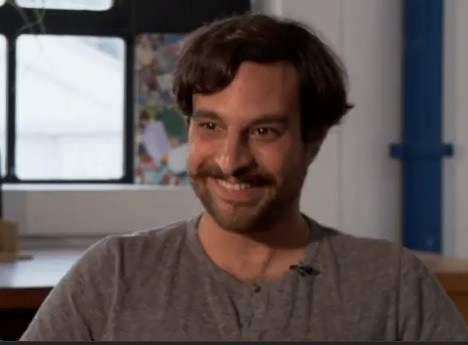SF Symphony scales Bluebeard's Castle
 Michelle DeYoung plays Judith, Bluebeard's new wife in the San Francisco Symphony production of Bartók's Duke Bluebeard's Castle. Below: Bluebeard director Nick Hillel. Photos courtesy of SF Symphony
Michelle DeYoung plays Judith, Bluebeard's new wife in the San Francisco Symphony production of Bartók's Duke Bluebeard's Castle. Below: Bluebeard director Nick Hillel. Photos courtesy of SF Symphony
There are seven locked rooms in Duke Bluebeard's castle, and Nick Hillel knows what's in each one. From blood to torture to tears, the contents of the rooms were originally devised in French folklore and then formalized by the writer Béla Balázs for his friend, the Hungarian composer Béla Bartók, for the short opera Duke Bluebeard's Castle. But it was up to Hillel, who helms a London-based digital media company called Yeast Culture, to bring those mysterious chambers into the 21st century.
Hillel is the director of an acclaimed new production of Duke Bluebeard, which had its premiere last October with the Philharmonia Orchestra under the direction of Esa-Pekka Salonen. After a tour through Europe, the production comes to Davies Symphony Hall for three performances by the San Francisco Symphony.
As conceived by Hillel, who has worked with artists as diverse as the Beastie Boys and Cirque du Soleil, Davies is transformed by a stage-engulfing set that is 24 feet high onto which he projects all sorts of wild video projections (the seats behind the orchestra are not in use for this performance). And hovering over the orchestra itself is what Hillel calls "the sails," a sculptural origami-like structure that also provides projections surfaces as it unfolds over the course of the hour-long opera.
"I wanted the sails to mirror the character Judith's journey," Hillel explains in the sunny Davies lobby before a rehearsal. "She has just arrived at the castle of Duke Bluebeard, her new husband, and she wants to know what's behind all the locked doors. The deeper she goes, the more is revealed and the more we see."
Bluebeard's American premiere was with the New World Symphony in Miami under the direction of Michael Tilson Thomas, who also conducts the San Francisco performances. But the Miami performances did not include the full set and full complement of six projectors that will be part of the San Francisco run.
In conceiving the production, Hillel, who was a fan of the 1918 opera, knew he wanted to delve into the subtext of the story – a wife unlocking all her new husband's secrets, even as he pleads with her to simply love him and let the secrets lie – without overwhelming the music.
"I love a challenge, and the challenge here was not to be too literal with the story and not to overwhelm the music or overcrowd it with ideas," he says. "I know that I have tremendous power as a video artist, and that power can outweigh what is right. I can ruin the experience by directing attention with a color or an image when attention should be on the emotion of a singer or passage of music being played by a certain instrument. I wanted to do some delicate work here with lighting and images."
In keeping with his notion of not taking things too literally, Hillel worked with his team – most of which traveled with him to San Francisco – to create images that, even if they weren't literal or specific to the story, evoked just the right emotion. He's even using the orchestra itself to help set the mood.
"You have this huge, beautiful orchestra on stage, so you have use it," he says. "For instance, there's a recurring 'blood' theme in the score, and depending on which part of the orchestra is playing it, we light the musicians in red. It helps with the storytelling and moves the recurring themes forward."
Described as "semi-staged," the production could be better described as "almost staged." If the orchestra weren't on stage, you'd still have two actors – mezzo-soprano Michelle DeYoung as Judith and bass-baritone Alan Held as Bluebeard – in costume and inhabiting the towering castle set and its ever-changing projections. Talk about your hybrid projects – here you have an opera performed with an on-stage symphony orchestra with a set designed for a venue that's not used to housing sets. As Hillel says, he likes a challenge.
"We tend to piss off the opera purists," Hillel says with a laugh. "Some of them just don't like the use of video. Some say we use too much, some say we don't use enough. Some people love it; some people hate it. You can't please everybody. If everybody liked it, it would probably be middle-of-the-road, and what's interesting about that?"
In keeping with the unusual, adventurous spirit of Bluebeard, the Symphony is planning some special events. Laura Stanfield Prichard gives a pre-show take an hour before each performance (free to all ticket holders). And on Friday, June 22, things get really interesting with Davies After Hours, a post-concert music event featuring the Magik*Magik Orchestra with special guest John Vanderslice performing their musical response to Bluebeard. The event will also feature artwork curated in partnership with the Crucible in Oakland. The event is free to June 22 ticket holders.[bonus video]Nick Hillel, director of Duke Bluebeard's Castle discusses his concept for the production.FOR MORE INFORMATIONThe San Francisco Symphony's Duke Bluebeard's Castle is at 8pm Thursday, Friday and Saturday (June 21, 22 and 23) at Davies Symphony Hall on Grove Street between Van Ness Avenue and Franklin Street, San Francisco. Tickets are $35-$145. Call 415-864-6000 or visit www.sfsymphony.org.
